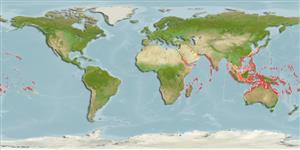Common names from other countries
Environment: milieu / climate zone / depth range / distribution range
Sinh thái học
Biển Cùng sống ở rạn san hô; Mức độ sâu 0 - 35 m (Ref. 37816), usually 5 - 35 m (Ref. 27115). Tropical; 24°C - 27°C (Ref. 27115); 35°N - 36°S, 28°E - 124°W
Indo-Pacific: Red Sea and East Africa (Ref. 5469) to the Hawaiian, Line, Marquesan and Ducie islands, north to southern Japan, south to New Caledonia and the Austral Islands. Unknown from the Persian and Oman gulfs (Ref. 11441).
Bộ gần gũi / Khối lượng (Trọng lượng) / Age
Maturity: Lm ? range ? - ? cm
Max length : 22.0 cm TL con đực/không giới tính; (Ref. 30573); common length : 18.0 cm TL con đực/không giới tính; (Ref. 30573)
Các tia vây lưng cứng (tổng cộng) : 10; Các vây lưng mềm (tổng cộng) : 11; Tia cứng vây hậu môn: 3; Tia mềm vây hậu môn: 6. Body yellowish with broad blackish stripe on upper side; head and anterior part of body with small dark reddish spots (Ref. 5469).Color changes with growth as well as varies among adults (Ref. 37816). In Oceania, juveniles are a golden green dorsally and white ventrally; in continental areas juveniles may be red dorsally (Ref. 37816). The maroon and yellow phase was originally described as a distinct species, P. typee (Ref. 37816).
Inhabits clear lagoon or seaward reefs to at least 33 m depth (Ref. 9710), but may venture very deep. Occurs openly on coral and soft-bottom habitats, occasionally in pairs (Ref. 48636). Benthic (Ref. 58302). Tends to perch on outermost branches of Stylophora, Pocillopora, and Acropora corals (Ref. 9710). Feeds mainly on small fishes and crustaceans, sometimes on shrimps and is territorial and haremic (Ref. 37816). Solitary on corals (Ref 90102). Marketed mostly fresh. Minimum depth reported taken from Ref. 128797.
Life cycle and mating behavior
Maturities | Sự tái sinh sản | Spawnings | Egg(s) | Fecundities | Ấu trùng
Distinct pairing. Spawning ascents into the water column occurred over a distance of 1.0 to 2.5 m (Ref. 26305).
Randall, J.E., G.R. Allen and R.C. Steene, 1990. Fishes of the Great Barrier Reef and Coral Sea. University of Hawaii Press, Honolulu, Hawaii. 506 p. (Ref. 2334)
IUCN Red List Status (Ref. 130435)
CITES (Ref. 128078)
Not Evaluated
Threat to humans
Harmless
Human uses
Can't connect to MySQL database (fbapp). Errorcode: Too many connections
